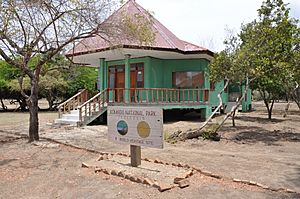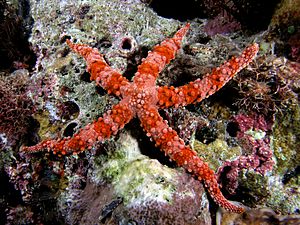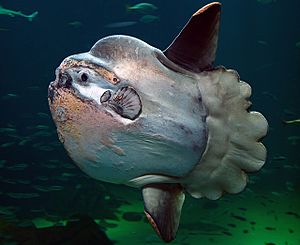Komodo National Park facts for kids
Quick facts for kids Komodo National Park |
|
|---|---|
| Taman Nasional Komodo | |
|
IUCN Category II (National Park)
|
|
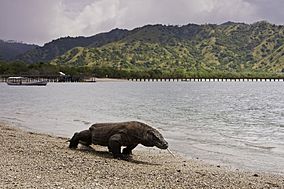
Komodo dragon at Komodo National Park
|
|
| Location | Lesser Sunda Islands, Indonesia |
| Area | 1,733 km2 (669 sq mi) |
| Established | 1980 |
| Governing body | Ministry of Environment and Forestry |
Komodo National Park is a special national park in Indonesia. It is found among the Lesser Sunda Islands. This park includes three big islands: Komodo, Padar, and Rinca. It also has 26 smaller islands. In total, the park covers about 1,733 square kilometers. About 603 square kilometers of this is land.
The park was started in 1980. Its main goal was to protect the Komodo dragon. This is the largest lizard in the world! Later, the park also began protecting many other animals and plants. This includes amazing creatures in the ocean. In 1991, UNESCO named Komodo National Park a World Heritage Site. This means it is a very important place for everyone to protect.
Komodo National Park was also chosen as one of the New Seven Wonders of Nature. The waters around Komodo island are full of different kinds of sea life. The Komodo islands are part of the Coral Triangle. This area has some of the richest ocean life on Earth.
Contents
History of Komodo National Park
Komodo National Park was created in 1980. In 1991, UNESCO recognized it as a World Heritage Site. They also called it a Man and Biosphere Reserve. This means it is a place where nature and people can live together.
The park was first made to save the unique Komodo dragon. Scientists first learned about these dragons in 1912. Since then, the park's goals have grown. Now, it protects all the different kinds of life in the area. This includes animals and plants both on land and in the sea.
Many people live in and around the park. Most of them are fishermen. They came from different parts of Indonesia. The original people of Komodo, called the Ata Modo, still live there. Their culture and language are slowly mixing with new people.
Amazing Animals and Plants
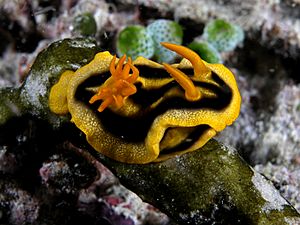
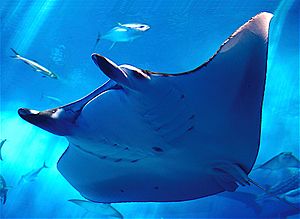
The weather here is very dry. It has a lot of savannah plants. This makes it a perfect home for the Komodo dragon. These dragons live on a few islands. About 1,700 live on Komodo. Around 1,300 are on Rinca. Smaller groups live on Gili Motang and Gili Dasami. About 2,000 dragons live on Flores. Sadly, they are no longer found on Padar.
You can find cloud forests in a few places above 500 meters. These forests are home to special local plants. Along the coast, there are mangrove forests. These grow in the calm bays of the three main islands.
The park's ocean is full of life! You can see huge whale sharks and ocean sunfish. There are also graceful manta rays and eagle rays. Tiny pygmy seahorses hide in the corals. You might spot colorful nudibranchs and even the blue-ringed octopus. The waters are also home to many sponges, tunicates, and beautiful corals.
Many types of whales and dolphins live in these waters. This includes small dolphins, huge sperm whales, and even blue whales. Rare Omura's whales have also been seen here. Endangered dugongs, which are gentle sea cows, also live in the Komodo area.
The land animals are not as diverse as the sea animals. But the park is still very important for protecting them. Many mammals here came from Asia. These include the Timor deer, wild boar, and water buffalo. You can also see crab-eating macaques and civets. Some reptiles and birds are from Australia. Examples are the orange-footed scrubfowl and the lesser sulpher crested cockatoo.
The most famous reptile in Komodo National Park is the Komodo dragon. It is the biggest lizard in the world! It can grow to be 3 meters (10 feet) long or more. It can also weigh over 70 kilograms (150 pounds).
There are 12 different kinds of snakes on the islands. This is in addition to the sea snakes. Saltwater crocodiles used to live in the park's coastal areas. They lived in places like mangrove swamps. But now, they are no longer found here.
One common bird is the orange-footed scrubfowl. This bird lives on the ground. In the savannah areas, 27 different bird species have been seen. The zebra dove and spotted dove are very common. Two types of eagles live in the park. These are the white-bellied sea eagle and the very rare Flores hawk-eagle.
Visiting Komodo National Park
Scuba diving is very popular here. This is because the park has so much amazing sea life. Komodo Island and Rinca were once connected to Flores. They are separated from Sumbawa Island by the Sape Strait. The ocean in this strait is hundreds of meters deep.
The Pacific Ocean to the north and the Indian Ocean to the south are at different heights. This causes strong currents to flow between them during tides. These currents are some of the strongest in the world. In the shallow waters along the east coast of Komodo, these currents can be very dangerous. It is important to have experienced guides.
More and more people are visiting the park. In 2009, about 36,000 people visited. This grew to 45,000 visitors in 2010. Most visitors come from other countries. This is because it costs a lot to travel to this faraway place. The park can welcome up to 60,000 visitors each year.
Many types of boat tours go through the national park. Tourist boats travel very often.
In July 2019, it was announced that Komodo Island would close for about one year. This closure started in early 2020. It was for a special program to help protect the island's nature.
Images for kids
See also
 In Spanish: Parque nacional de Komodo para niños
In Spanish: Parque nacional de Komodo para niños


